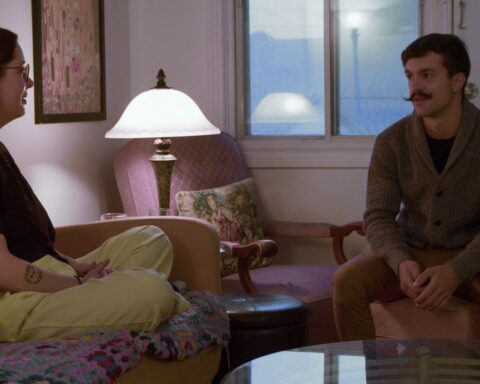At the 2014 festival holiday gathering for Telefilm and the Canadian Media Fund (CMF), documentary directors and producers sipped tea and nibbled on scones as they met, some for the first time, the bureaucratic employees who dispense $58-million each year to make Canadian docs. As an activist film director and producer, I wanted to talk to someone about the mandate of the CMF that forces filmmakers to become media-makers. Since 2010, the CMF has required that each documentary be produced with a digital component to accompany the linear narrative.
I got some of the answers I was looking for from the media liaison people at the CMF, Maurice Boucher and Pierre Campeau. But my big question was: does the interactive digital documentary (directly or indirectly) negatively affect the traditional narrative documentary? While they were not able to answer that query, they did provide me with a lot of relevant statistics. I wanted to know if people were watching interactive documentaries on-line, for how long, and if there was a way to measure the audience’s engagement with them.
Interactive docs: the latest buzz
Interactive documentaries are the latest buzz in non-fiction storytelling. Audiences are given a computer mouse to play creatively with the story. The web designers and graphic artists employed in this new genre are some of the finest fresh talent around since most interactive documentaries require a mix of animation, coding, programming and nonlinear storytelling. It’s clear that producing interactive docs requires filmmakers to work with a wide assortment of artists whose skill sets are quite different from their own. As such the CMF requires documentary filmmakers to partner with an approved media production company. These companies are new to the field of documentary filmmaking, and the resulting union of traditional and new media artists has produced some unique works of art. Digital media is a fast-growing field. Already there are just about twice as many digital media producers as TV producers. (More statistics can be found on the CMF’s website.)
Interactivity is often heralded as the next evolution of media. Certainly the CBC/SRC and the NFB/ONF believe in it. The president of CBC/SRC, Hubert T. Lacroix, wants to produce content for “widgets,” while at the same time he has eliminated their renowned in-house documentary unit. Lacroix’s argument for downsizing the non-fiction filmmaking departments of the CBC/SRC, aside from the obvious budget cuts from the federal government, is that he wants to focus on a new digital, on-line and mobile CBC.
At the CBC’s annual public meeting in Montreal on November 19, 2014, Lacroix stated: “Some content will remain in its current format, and some won’t. It will be produced based on the mobility and intimacy that we are seeking. It will be more than a simple extension of, or add-on to, our traditional broadcasting services. Concepts of immediacy, interaction, and impact have to be reinvented.” (Lacroix’s full statement can be viewed here.) In the 2014-15 budget report, five per cent of all programming would be allocated to digital content, and this number is likely to rise with the new CBC mandate. Mobility, intimacy and interaction come at a cost, and at a time of fiscal restraint those costs dig deeper into the programming choices directly affecting the narrative-content documentary.
The NFB now spends 27 per cent of its total budget on interactive projects (not all of which are documentaries). Michelle Van Beusekom, the director general of the English programme at the NFB, described the interactive documentary as a marriage of forms and genres. “They explore the relationship between form and content and interactivity in an effort to add new layers of meaning and audience engagement to the story.” I asked her why the NFB wants to support interactive documentaries. “As a public producer, the NFB has always played a leadership role in experimenting with the application of new technologies to storytelling…” Van Beusekom listed a number of the important things the NFB has pioneered in the past (direct cinema, IMAX, animation, CGI, etc.), then continued. “The money model for financing this kind of work is still nascent. As a public producer, we’re able to operate in this space—much like an R&D lab—and start to explore its application to storytelling, thereby laying groundwork for subsequent creators and producers.”
Filmmaker responses
I asked several filmmakers about their experiences working on interactive documentaries. Amy Miller (director of The Carbon Rush and No Land No Food No Life) calls herself a traditional narrative-documentary filmmaker: “I wouldn’t have made an interactive if I wasn’t forced into it.” She described a funding model that requires filmmakers to partner with accredited media companies: “I had three companies that were approved by the CMF to work with, not the people I wanted to make Carbon Rush: the Game with.” Yanick Létourneau (Périphéria Productions, producer of documentaries and digital content, including Sur la piste des DJs) confided in me that he tries to watch interactive documentaries, but they fail to live up to their hype. While he is proud of his own work in the interactive field, he was very skeptical. “To me the whole thing is a complete waste of money. It diverts our attention from making relevant works.”
Kevin McMahon (Primitive Entertainment, director/producer of Waterlife and The Polar Sea) is more optimistic, describing a new form that is still in its infancy: “We have barely scratched the surface of what interactives can do. Interactive docs are the future.” McMahon considers himself a nonlinear filmmaker, someone who continues to challenge forms and conventions, and the artistic theoretical possibilities of the interactive documentary excite him. But when asked if he would make an interactive documentary at the expense of a narrative-doc film, he was quick to respond, “No, I love making film. I would never want someone to tell me not to make films.” Waterlife is one of the NFB’s most celebrated and award-winning interactive documentaries, but McMahon would rather people watch his narrative feature-length version, which he feels makes the important points he wants his audience to understand about the ecological disaster facing the Great Lakes. The interactive version, though it has had over a million unique visits, does not get the kind of sustained viewing that takes place when a viewer watches a feature doc.
Interactive docs: the stats
There is something interactive producers don’t want you to know when they talk about their documentaries: the stats. Statistics such as the number of unique visits to an interactive documentary and the amount of time a user/audience member sticks around to watch, play or interact with the web doc. There is a reason producers will not give you this information, and that’s because the numbers suck. The CMF has collected information from many of those producers and Pierre Campeau, communications manager at the CMF, shared with me the general outline: “CMF-funded digital media documentary projects report average visit lengths of between two to three minutes.” Astonishingly, the most successful web docs keep the viewer on-line for 10 minutes. Considering most web docs have hours of content to view or interact with, 10-minutes-max is a terrible viewing ratio: it’s the equivalent of every audience member walking out of the cinema before the 15-minute mark of a feature-length film. In any other medium, this kind of poor retention would be considered a complete and utter failure.
Details of interactivity
A detailed look at the different forms of interactivity used in on-line documentaries can help to reveal the peril and potential in web docs. Most on-line documentaries are made up of one or more of the following elements: Timeline, Branching Narrative, Mosaic, Collaborative and Games. As the form becomes more interactive (increased audience/ user choice), the less narrative the documentary retains. Herein lies the paradox: increasing interactivity means decreasing narrative power. Call it experiential vs. narrative, where the priority is to give the audience or user of the site an experience, rather then create a powerful narrative.
The most common and least interactive form in web docs is the Timeline. This is a traditional documentary delivered on-line in chapters, pages or a scroll that is ordered consecutively, much like a timeline to a story. The narrative is largely intact and the media plays out without the users having any real control over the ordering of events. Most of the interactivity, if you want to call it that, is peripheral to the main story line. A good example of a timeline iDoc is the NFB’s Pine Point, which has some of the best audience–viewing time ratios, as most viewers tend to watch the entire web doc from start to finish (it can be viewed in 10 to 20 minutes). Structured like a photo album, Pine Point can be played much like a traditional documentary, assuming that the clicks and scrolling needed to keep the story going has been automated.
Next, there is the Branching Narrative, a ‘choose your own adventure’ format, which generally uses first-person perspectives combined with multiple-choice options to reach a series of alternative endings. The branching narrative is a production nightmare from a financial standpoint: every time the story branches, the costs multiply and the audience divides. Imagine producing eight different endings when it takes six months to execute one good one. Examples of this type of production are Inside Disaster: Haiti and Remembering Bogle Chandler. Mosaics are highly designed and visually spectacular interactive docs but lack story direction. This kind of web doc, as the name suggests, resembles a tiled wall of small images. Mosaic homepages are generally full of many small pictures that reveal many more video shorts. Here you have a picture that when clicked upon leads to a short video that is clustered in some thematic way to suggest a cohesive story. Most viewers never make it down the rabbit hole to discover any specific ending. While this is in theory an interactive site, it resembles the web itself, only miniaturized, and as such it’s not long before you get lost. Examples include The Tiziano Project 360°, The Whale Hunt and 7 billion others.
With the Collaborative form, the audience is invited to contribute to the web doc. These on-line projects are comparable to YouTube: an idea is put forward (share X experience with the world) and anyone with an interest in that premise and a recordable device can upload content to build it within the hosted site. Audience-generated content for a documentary can obviously raise serious concerns for most filmmakers, the least of which is quality, coherence and narrative control. While the interaction is clearly more advanced than the timeline model, this is a long way from the model of the auteur documentary filmmaker. The singular voice is intentionally lost in the din of the collaborative model. Public participation can be a great component of a documentary, but when the story is centered on crowd-sourced material, the narrative is anybody’s guess. Examples are Mapping Main Street, One Day On Earth, Digital_Nation.
Games in on-line documentaries take interactivity to a higher level of direct choice, control and response. The user gets to interact in a first-person simulation that plays out over a non-fiction scenario. Games may be the answer to the interactive paradox, since a greater number of users take the time to ‘play’ the documentary. But is this taking the documentary genre too far? Is it possible for games and non-fiction to marry without profound challenges?
Games—the conundrum
Interactive documentary games are problematic on two levels. One: the ethical quandary of ‘truth claims’ becomes a minefield when the user is allowed to question the basic premise of the story: how can a ‘game’ offer us a ‘truth’? Replaying history can lead to ethical quandaries of revisionism. Two: the objective is to ‘win’ rather than discover or learn. Personal success can blur the lines of what a documentary is trying to achieve. Do we want winners and losers or do we want issues to be clearly defined and a story to be understood?
Games and, to a lesser extent, branching narratives suggest to the viewer a perspective that is akin to historical revisionism. History is shapeable and can be reshaped at any time by revisionist historians with new facts and interpretations of known ones. While this is actually an important aspect of documentary work, it can be widely abused. The use of games opens up ethical challenges. What happens when the media-makers decide that the game is more important than accurately retelling the events from the past?
At first glance the interactive level of games challenges the simple binary I have laid out: that increased interactivity in docs will inevitably decrease narratives and the interest of users. But conventional digital games (non-documentary ones) are at the pinnacle of the interactive world. They represent some of the most advanced graphics, real-time interactivity and multiplayer worlds created. Digital games also have some of the best viewer-participation statistics. Kids will avoid going to the bathroom for hours to keep playing a game, and they will spend fortunes on a parallel consumer world of virtual material items, not to mention purchasing the software of the game itself.
But while a good game structure can hook some users into a documentary and the unique-visitors stats for interactive documentary games are a little better than other interactive documentary forms, the narrative is compromised. It is no longer the narrative structure—the true doc content—that is keeping the audience in the game. A world has been created and the narrative is as random as the game-play. No interactive game documentary currently built is comparable to Grand Theft Auto or Assassins’ Creed, technically or creatively, but web-doc producers are trying to get there. And when they do, I am not sure what our profession will have become.
Pipe Trouble is a good example of the ethical conflicts created by games. Originally a companion piece to the documentary Trouble in the Peace (dir. Julian T. Pinder, 2012), the game’s objective is to build a pipeline through a farmer’s field fast enough that the gas keeps flowing but not in a way that disturbs the farmer or protesters who will then blow up your pipeline. In reality, it is a simple Tetras game: assemble the pieces of pipes in order to complete the gas line. When the site went live, Dawson Creek Mayor Mike Bernier and Fort St. John Mayor Lori Ackerman of B.C. (towns that happened to have gas pipelines in the works) and then–federal Minister of Culture James Moore got upset and claimed that the game endorsed eco-terrorism. The swelling of public condemnation caused the site to be temporarily shut down, forcing TVO, the sponsoring broadcaster, to conduct a review, which found no hidden terrorist activity buried in the code. Because it was a ‘game,’ Pipe Trouble was much easier to shut down. A traditional documentary would be immediately defended as the right of the artist to freedom of expression but with a game, this ethical boundary is blurred, and so is our perception of the veracity of the content of a game documentary.
Interactive > Narrative
The enthusiasm for interactive docs conceals a profound paradox: the more interactive a web doc, the less narrative coherence there is and, consequently, the less engaged the audience. The more options viewers are given to explore, the less likely they are to watch all or even a significant portion of the doc through to its completion.
When interactive projects do retain audiences, the basic principle of a documentary is challenged as the experiential aspect of interactivity consumes the narrative. Without a strong narrative at its foundation, a documentary loses its core storytelling power and with it the ability to affect audiences and impact society in ways that the genre has championed for over a century.
As a documentary producer, it’s my belief that the essence of a film is located in its narrative. With strong narratives we are able to impart meaning, illustrate complex issues and influence our audiences. Documentaries give artists and filmmakers the power to fight corruption, challenge norms and debate moral quandaries. These are the reasons I make documentaries. I believe the form of the interactive documentary fundamentally challenges the ability to effect social and political change.
There is something inherently oppositional between narrative and interactivity. Narrative is about order and control over time and space, while interactivity is all about giving up that order. While the new possibilities that interactivity presents (open-source conversations, direct feedback and social dialogue) are exciting, the format poses a huge threat to the auteur, the old-school filmmaker and control-freak director.
There is a perception that the ultimate form of communication is fully immersive. Interactivity may offer the nirvana of a learned experience that can be felt intensely both physically and emotionally. The hard-core proponents of interactivity believe the more choices we are given in how we experience the story, the more chances we will have at achieving nirvana. It can be summed up with this Chinese proverb: “Tell me I’ll forget / Show me I’ll remember / Involve me I’ll understand.” If you accept that doctrine, then interactivity pushes the experiential form of storytelling over the narrative form. You must feel it, use multiple senses, be active, make choices and then you will understand because you have experienced something.
But that isn’t how interactive docs work. The majority of interactive documentaries break down concepts into small bite-sized story segments that can stand alone or work within a larger thematic. This makes for disjointed viewing. Most Internet viewers start an interactive doc, get distracted by something else (on-line or in real life) and then may or may not come back at a future time to the site. This type of viewing does not create a sustained experience or allow for the building of a powerful narrative.
Documentary has a long history of playing an integral role in the consciousness of society, of having a direct role in the shaping of the public sphere and of affecting the important decisions we make collectively. It is, in a word, ‘political.’ The power of this politic is in the narrative ability to clearly and powerfully articulate an issue, debate social conflict or champion a cause. The danger is that by prioritizing the interactive and experiential over the narrative, the power of the politic is diminished and the documentary becomes less influential to society at large.
Recommended Web Docs
From the NFB:
Fort McMoney
A first-person documentary game about exploring the tar sands of Alberta
Here at Home
A mosaic portrait of social-assistance housing
Bear 71
You’re a bear in the woods; this is your life shown in 20 minutes
From ARTE:
Type:Rider
A game in which rolling umlaut balls take you through typographic history
Cinemacity
A locative media project that takes you down the memory lane of Parisian film classics
Webdog
An interactive portrait of man and woman’s best friend
From the independents:
The Whale Hunt
An Inupiat Eskimo hunt of a whale in Alaska framed by the beat of a heart
I Love Your Work
A portrait of everyday life for lesbian porn actors
Hollow
The resilience and depression that is life in West Virginia
From Korsakow Films:
Planet Galata
Istanbul’s famous bridge and the people who cross it
Ceci n’est pas embres
Professor Matt Soar’s illusionary sabbatical in France











